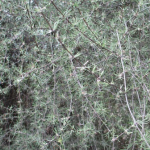My List
6 favourites found.Fuchsia procumbens (Creeping Fuchsia)

Fuchsia procumbens, or Creeping Fuchsia, is a rather exotic Fuchsia, unlike most common types, unique for its creeping habit. This species grows much like a groundcover, often not exceeding more than a few inches in height. Bears pretty rainbow flowers followed by firm-fleshed, edible berries.
It is now a rare species in the wild because of the destruction of its natural habitat and is listed as an endangered plant species.
Habitat: Fuchsia procumbens is a prostrate shrub that is endemic to coastal areas of the North Island of New Zealand. A strictly coastal species. F. procumbens has been collected from cobble/gravel beaches, coastal cliff faces, coastal scrub and grassland, dune slacks and swales, and from the margins of saltmarshes (in places where it would be inundated during spring tides).
Flowering: Spring - Summer [September - May]
Fruiting: Summer - Autumn [November - July]
My Lists: Rare Plants
Melicytus alpinus (Porcupine Shrub)

Melicytus alpinus get their common name, porcupine shrub, from the long, almost leafless, spindly branches which resemble the quills of a porcupine. Its leaves are narrow and generally have smooth margins with a few exceptions with serrated edges, however, they do only have a small amount of leaves and they are only approximately 1cm long. Hard and dense, slow-growing in coastal or alpine areas of southern North Island and the South Island it looks almost leafless. But most of the leaves are sheltered between the stiff interlacing stems as an adaptation to the harsh environment where the plant grows. Leaves are variable, leathery.
Melicytus alpinus is very well adapted to extreme weather conditions such as drought, which is why it can be found in areas such as the heavily modified high country of the South Island.
Melicytus alpinus is a habitat to many lizards endemic to New Zealand, this group of lizards include both skinks and geckos. This relationship is mutually beneficial as the lizards use the porcupine shrub as protection from weather and/or predators and in turn eat and spread the seeds from the shrub's berries.
Habitat: Occurs east of the Southern Alps in exposed rocky places between 600m and 1.300m. Found in the wild on very light sand or rocky soils, or on rock outcrops in full sun though it grows on any well-drained soil.
Flowering: Summer [November - January]
Fruiting: Autumn [February - April]
My Lists: Rare Plants
Olearia adenocarpa (Small-leaved Tree Daisy)

Olearia adenocarpa is a critically endangered species, threatened by browsing animals and habitat loss. A spreading, small leaf shrub with fragrant flower. Clip to keep compact. Withstands harsh, drought-prone places. Only found on a few sites on dry rocky old river channels near the Waimakariri and Rakaia Rivers.
As part of the dry woodland community, it plays an important role in conditioning the soil. The soil conditioning creates a more hospitable environment for less robust species and broadleaf/podocarp forest succession. Other plants in this community include but are not limited to Discaria toumatou, Poa cita, Ozothamnus leptophyllus, Corokia cotoneaster, Melicytus alpinus and Cordyline australis.
Habitat: A lowland species of recently deposited alluvial gravels and sands. Generally grows in degraded to unimproved dry grassland along the dry stony terraces and channels that border a braided riverbed.
Flowering: Summer [January - February]
Fruiting: Autumn [February - March]
My Lists: Rare Plants
Olearia lineata (Small-leaved Tree Daisy)

Olearia lineata is one of the best native plants for hedging with fine grey, willowy foliage. Fast growing and hardy, forming a graceful tree, bearing masses of erect twigs with clusters of small very thin leaves that are white underneath, on the margins of steep river gorges and amongst rocky outcrops. Bushy tree up to 6m tall with a fragrant white flower. Evergreen. Hardy.
Habitat: A rare, at-risk and in decline tree endemic to the South Island of New Zealand. Found mostly in the east in damper sites from lowland to 300m above sea level. Found on tussock grassland and forest margins, river terraces. Also found on the margins of steep river gorges, and amongst rock outcrops, boulder field and at the toe of alluvial fans.
Flowering: Summer [November - January]
Fruiting: Autumn [January - April]
My Lists: Rare Plants
Pimelea declivis
 Sold Out
Sold Out
Pimelea declivis is a small blue-green erect shrub native to Canterbury. Inhabiting limestone outcrops from south Marlborough to south Canterbury.
Habitat: Lowland to lower montane, Mostly found in sparse grassland and grey scrub associated with limestone ridges, scarps, cliffs, outcrops, screes and boulder heaps.
Flowering: Spring - Summer [October - May]
Fruiting: Summer - Autumn [November - May]
My Lists: Rare Plants
Pittosporum obcordatum (Heart-leaved Kohuhu)
 Sold Out
Sold Out
Pittosporum obcordatum is a rare, tall column shaped tree native to New Zealand. Naturally grows throughout New Zealand most commonly in eastern lowland alluvial forest favouring sites that are prone to summer drought in order to avoid water logged soils. It gets its column form form the dense interlaced twigs and branchlets that completely cover the trunk. The species has many small rounded leaves and produces small red, pink and yellow fragrant flowers in late spring. Does best in moist, fertile soil in semi-shade.
Habitat: A species of primarily eastern lowland alluvial forest, favouring sites prone to summer drought being otherwise waterlogged, and frost-prone during winter.
Flowering: Spring [September to December]
Fruiting: Summer [December to May]
My Lists: Rare Plants
